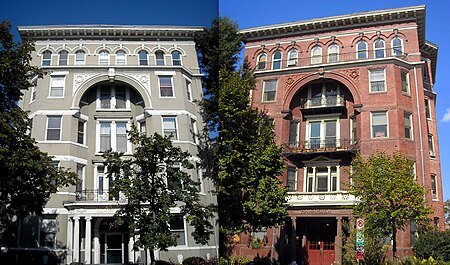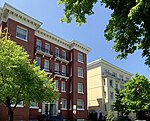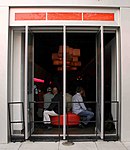Gladstone and Hawarden Apartment Buildings
Apartment buildings in Washington, D.C.Historic district contributing properties in Washington, D.C.NRHP infobox with nocatResidential buildings completed in 1901Residential buildings on the National Register of Historic Places in Washington, D.C. ... and 1 more
Romanesque Revival architecture in Washington, D.C.

The Gladstone and Hawarden Apartment Buildings are historic twin buildings located in the Logan Circle neighborhood of Washington, D.C. Built in 1900 and 1901, the Gladstone and Hawarden are early examples of middle class apartment buildings in the city. They were designed in the Romanesque Revival architectural style by prominent local architect George S. Cooper. The buildings, since converted into condominiums and a housing cooperative, were added to the National Register of Historic Places (NRHP) in 1994.
Excerpt from the Wikipedia article Gladstone and Hawarden Apartment Buildings (License: CC BY-SA 3.0, Authors, Images).Gladstone and Hawarden Apartment Buildings
R Street Northwest, Washington
Geographical coordinates (GPS) Address Nearby Places Show on map
Geographical coordinates (GPS)
| Latitude | Longitude |
|---|---|
| N 38.912777777778 ° | E -77.033055555556 ° |
Address
R Street Northwest 1423
20009 Washington
District of Columbia, United States
Open on Google Maps









